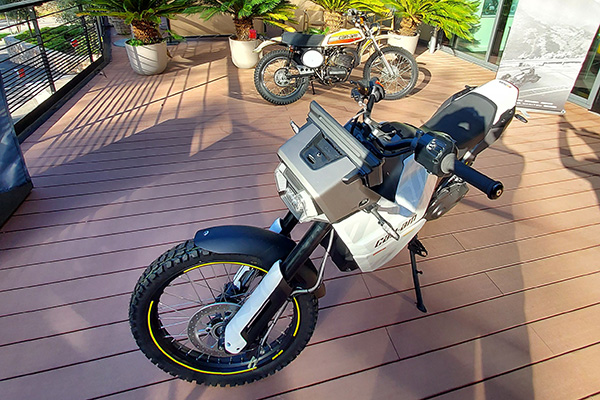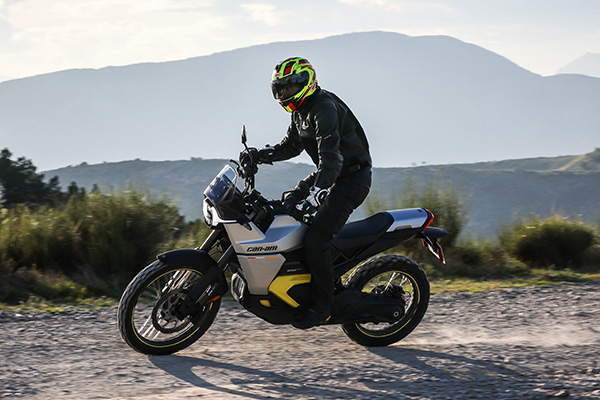Yes, you can draw a line joining a 1973 classic and a 2024 bike of the future
Iain Macauley, Automotive Journalist, talks us through his most recent visit to see Can-Ams new electric motorcycle range which promises to be ‘retro inspired’.
You'd be forgiven for being cynical when in the first paragraph of a new motorcycle launch press release the words "retro inspired" appear - until you meet the people tasked with making something decades old relevant to something cutting edge.
Can-Am motorcycles haven't been seen in showrooms since 1987, launched in 1973 by the - you guessed it - Canadian manufacturer (with factories in the US). Its parent company, Bombardier, was founded in the 1920s, and initially made "snow utility vehicles". Can-Am bikes back then were powerful Rotax-engined two strokes.
So when, as part of the launch of Can-Am's new electric motorcycle range, I was invited to visit the Bombardier Recreational Products (BRP) design centre to hear about retro-inspiration, there was a bit of a cynic harrumphing in the back of my mind.
Until I'd been there about 30 seconds....

You'd probably expect me to say I'd been Business Class-ed off to Canada for a junket around a gin palace full of silent and frowning creatives dabbling with out-there computer-based design programmes, and smart-ass AI.
But, no: BRP's European design centre, led by a Richard-Gere-alike Nicolas Deluy, is nestled in the peaceful and wooded foothills of the mountains north west of Antibes, in France. Outside, on a terrace in front of the design office, were two Can-Am electric motorcycle prototypes - and a UK-sourced M-reg 1973 Can-Am 175 ISDT. There's probably Can-Am trail bike enthusiasts out there been searching for that bike for years...
It was the inspiration, sure enough, for the trail version of the new Can-Am - the Origin - and provided cues for the design of the road bike, the Pulse.
You don't get much closer for genuine inspiration than being able to overlay a side-on view of the Origin (which genuinely felt pretty competent off-road) upon a side-on view of the 1973 machine. There's a lot of things in the same if not very similar relative places, crucially things like wheels and handlebars.
But you also get an insight into how designers connect decades-old design with brand new - and completely unrelated, construction-wise - machines.

The 1973 bike had been a very and ever-present reference point for walk-around studies by the team, which led to initial pencil-drawn sketches, before moving on to designers' screens, then into a shuttered "no entry to unauthorised personnel" workshop where models and prototypes are created. You should have seen the look on the modeller's face when she opened the door just as I was looking towards it...
Everything hangs around the original 1973 Can-Am tank design. While some elements of the Pulse and Origin clearly feature that "irregular pentagon" shape and logo - the Pulse's "tank" for one (actually an electrical gubbins cover) - both bikes feature variations upon that shape throughout which you do actually pick up.
Not necessarily a cue for you to say, pub-quiz-expert-like, "ah, that looks just like a 1973 Can-Am tank" - it's more like an inspiration to incorporate a shape that is exclusive to Can-Am's motorcycle history. After all, we usually want a bike that looks different and distinctive from the rest.
By all accounts, those early Can-Ams were, well, exciting rides: peaky and powerful two-strokes, limited suspension travel. Your initial thoughts are that a tech-laden electric motorcycle will never have that kind of challenging character - current-day health & safety or construction & use authorities will see to that - but, actually, both new Can-Ams do in their own way.

There's no two-stroke ring-ding-a-ding, but if you're following an off-road Origin and the rider nails the throttle, not only does it take off like a Honda 750 Four, it also sounds like it.
Given it's a largely silent motor, other than a purposeful whine when cracking on - and these bikes have serious pace - it took me a while to work it out, but it's the tyres: under hard acceleration the Origin's knobblies make a sound like a distant four cylinder fossil-fuelled bike with a sports exhaust.
Do they feel anything like a retro 1970s two-stroke off-roader? Absolutely not.
Are they future classics? Well, back in the 1970s did we expect near-disposable two-strokes to ever gain that classic status...?

COMMENT